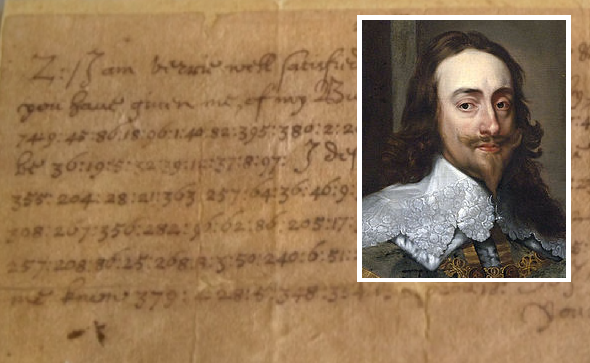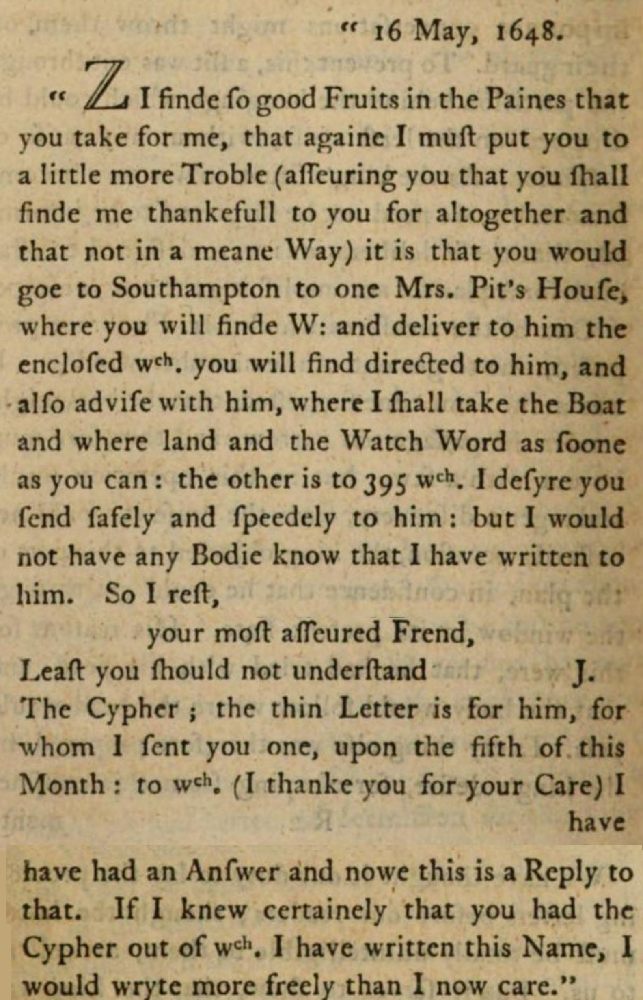Unsolved: A coded letter from Charles I to an accomplice
Cipherbrain readers Norbert Biermann, Thomas Ernst, and Matthew Brown have taken on another encrypted letter from the imprisoned King Charles I. It’s about an escape plan. It’s about an escape plan.
I hope that sometime in the next few years I will have the opportunity to visit Carisbrooke Castle on the Isle of Wight. This castle on the island off the south coast of England is supposed to be well worth seeing.
Charles I.
Also, Carisbrooke Castle has played an important role on this blog in recent weeks. The English King Charles I (1600-1649) was imprisoned there for about a year until shortly before his execution.
The prison conditions were extremely luxurious. Nevertheless, the king tried to escape. A video on Vimeo reports on this. The letter, which can be seen at 0:58, will be discussed later.
The encrypted letters
As you can read on Satoshi Tomokiyo’s website, Charles I of Carisbrooke Castle wrote several coded letters to his son, as well as at least one to the nobleman Edward Worsley. Matthew Brown has linked a video showing that some of these coded letters are on display at Carisbrooke Castle today. So I have included this castle in the Cryptologic Travel Guide that Christian Baumann and I have created.
As I reported last week, Norbert Biermann, Thomas Bosbach, and Matthew Brown solved four letters from Charles I to his son (dated September 2, October 3, and November 6 and 7, 1648). I am still thrilled by this success and proud to have been able to report on it on my blog.
Satoshi Tomokiyo has also published a report on the decipherment, which I highly recommend.
Charles’ letters of August 1, 1468 (to his son) and May 22, 1648 (to Edward Worsley) were written with a different nomenclator than the four mentioned. They are still unresolved.
The letter to Worsley
Norbert Biermann and Matthew Brown did not let up after their success and together with Thomas Ernst (also known to Cipherbrain readers as an excellent codebreaker) next took on the said letter from Charles I to Edward Worsley of May 22, 1648. This is mentioned in the video about the escape plan and is on display at Carisbrooke Castle.
Worsley was apparently Karl’s accomplice in the failed escape. Here is Satoshi’s transcription of the letter:
Z: / I am verrie well satisfied with the discreete & carefull account that you have given me of my Business & particularly that you did 208 343 294 74 9 45 86 18 96 1 40 82 395 380 2 20 3 230 388 45 36 4 11 7 43 31 62 270 248 now it will be 36 19 5 32 39 12 37 8 97 I desyre you to enquyre whether or not 396 213 355 204 28 21 363 257 64 36 46 9 32 395 42 35 14 53 38 23 18 50 88 but for this 236 308 267 356 282 96 62 86 205 17 356 66 50 97 206 231 248 38 1 20 2 230 388 46 36 257 208 86 25 268 8 3 50 240 6 51 248 416 303 78 9 68 45 in the meane Tyme lett me know 379 4 28 5 348 354 the …. 206 18 So I rest
Your asseured Frend,
J.
There is another letter from Charles I to Worsley, written about a week earlier, on May 16 (both letters can be found here). This letter is not encoded except for one word (“395”, it stands for a male person), but it mentions an encoding procedure and thus gives important hints.
According to Thomas Ernst, Charles I used the following alphabet for the encoded letter (it was used for a nomenclator):
1, 2, 3: | 4: | 5: | 6: | 7: | 8: | 9: | 11: | 12: | 14: | 17: | 18: | 19: | 20: | 21: | 23: | 25: | 28: | 31: | 32: | 35: | 36: | 37: | 38: | 39: | 40: | 42: | 43: | 45, 46: | 50: | 51: | 53: | 62: | 64: | 66: | 68: | 74: | 78: | 82: | 86: | 88: | 96: | 97: | 204: | 205: | 206: | 208: | 213: | 230: | 231: | 236: | 240: | 248: | 257: | 267: | 268: | 270: | 282: | 294: | 303: | 308: | 343: | 348: | 354: | 355: | 356: | 363: | 379: | 380: | 388: | 395: | 396: | 416: |
Matthew Brown suspects that the nomenclator used is divided something like this:
- 1-90: homophones and nulls
- 90-100: punctuation
- 100-200: word list I (specific words which are unused in this letter)
- 200-380: word list II (common words)
- 380-420: names and misc. additions
Thomas Ernst thinks that the most likely candidate for the mentioned code group “395” is Colonel William Legge. In addition, the three have already identified some terms or letters as well as blenders (unconditional code groups). Anyone who wants to know more should read the comments starting at #11 under my last article. It is extremely exciting to see how three top class codeknakers put such a puzzle under the microscope.
Thomas, Norbert and Matthew have already found out quite a bit about the letter. However, Matthew fears that not much more will be possible unless another text is found that is encoded with the same nomenclator and provides further material for analysis.
Can a reader assist the three codebreakers with additional insights? Are there other letters encoded with the nomenclator used? If so, I look forward to appropriate comments.
If you want to add a comment, you need to add it to the German version here.
Follow @KlausSchmeh
Further reading: Revisited: A terminology for codes and nomenclators
Linkedin: https://www.linkedin.com/groups/13501820
Facebook: https://www.facebook.com/groups/763282653806483/







Letzte Kommentare